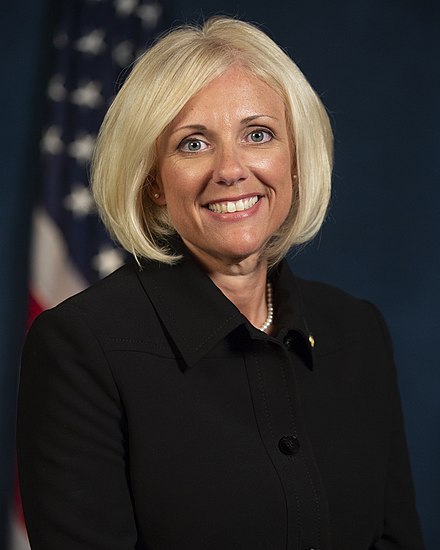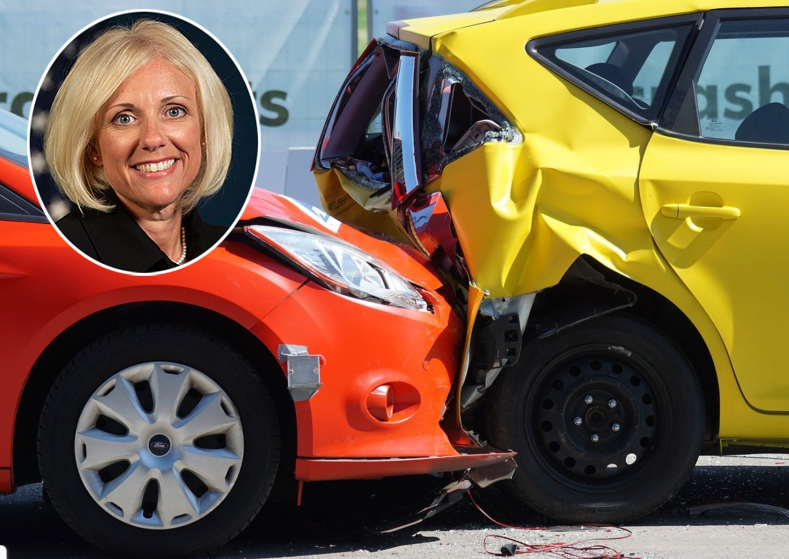For nearly a decade, countless transportation leaders across America have cited a misleading stat that 94 percent of car crashes are caused by "human error," implying that almost all roadway tragedies can only be avoided if road users learn to behave perfectly behind the wheel (or in the crosswalk, or the bike lane.)
That number, though, was actually pulled from a single 2015 National Highway Traffic Safety Administration study, which faced criticism from street safety advocates for ignoring the many ways that systemic factors encourage common and dangerous roadway behaviors, like road designs that suggest to drivers that it's okay to speed or state laws that allow motorists to text behind the wheel. Still, the "94 percent" myth remained featured on the agency's website for years.
That caught the attention of National Transportation Safety Board Chair Jennifer Homendy, who used a recent interview with the Associated Press as an opportunity to call on NHTSA to do better — and not just on its site copy. As the head of the government agency tasked with investigating transportation disasters, Homendy and her colleagues have issued thousands of recommendations aimed at changing the conditions that precipitate transport tragedies of all kinds, including the language agencies use to talk about them.
BREAKING:
— David Zipper (@DavidZipper) January 20, 2022
Today @NHTSAgov revised its website, removing the misleading claim that human error causes 94% of crashes.
Car companies and state DOTs might still repeat that mistruth, but they can no longer cite NHTSA's own language.https://t.co/GoOdDQHUnF
Before / after pic.twitter.com/wM9BbHMRAC
Just days after Homendy's statement to the AP, NHTSA quietly removed the 94 percent stat from its materials. And just days later, USDOT answered another one of the NTSB's most important reocmmendations: to put a "Safe Systems" approach at the center of its safety strategy, and reject the notion, once and for all, that "human error" alone is to blame for most collisions.
We spoke with Homendy about these recent achievements, and what she hopes every agency — including her own — will do next.
This interview has been edited for clarity and length.
Streetsblog: For people who aren't transportation wonks, a line on a government website that mentions that "94 percent of crashes are caused by human error" might not seem like a particularly big deal. Why did you think it was so critical for NHTSA to strike it from the agency's materials?
Jennifer Homendy: At the NTSB, we take a safe systems approach when do investigations of crashes in all modes of transportation. Do we look at the road user? Yeah. But we also look at the vehicle, the environment, the roadway conditions, the regulatory oversight, and all of that is factored into our recommendations. There is so much that goes into crash causation. So just using that statistic — and using it wrongly — it really bothered me.

When I talk about the public health crisis that is the number of people who are dying on our roads — and especially when I talk to people who are not in the traffic safety community — the response is, usually, "Well, of course. So-and-so’s texting. So-and-so drank. You’ve got people speeding. You’ve got an individual who’s at fault."
That’s not to say there’s no responsibility on individual decision-making. There is. But there are so many factors that cause a crash. When I hear the apathy — when I hear people say things like, “driving on the road is just a risk; people die” — it bothers me. It gets five seconds on the TV screen, and we move on.
I think, by saying this 94 percent statistic over and over again, that becomes a way for people to think, "Well, we can’t really do anything about it. [Road users] just shouldn’t make terrible decisions." But there are so many others who need to be held accountable for not taking action. Planners, designers, engineers, regulators at the state and local level — everybody. Then NHTSA put [the stat] on its automated vehicles page, and all of a sudden all of the AV people were using it as a way of saying, "well, see? It’s all human error! Our car will just fix it." When we all know that’s not true, either. When we say “94 percent,” it’s almost letting everybody else off the hook.
Streetsblog: So what percentage of crashes are caused by human error? I've heard some street safety advocates say that humans are to blame for 100 percent of crashes, when you include the engineers and automakers and policymakers and everyone else involved in making choices about our transportation system; I've also heard some say that it's zero percent, because these are systemic issues. Where do you fall on that spectrum?
Homendy: I’d say the individuals do have a responsibility to make the right decision for safety, but not just the individual in the car, and it's not just the individual who’s walking, rolling, cycling, or motorcycling on the road. It’s everybody involved in the decision making process — and more importantly, their failure to make decisions.
I do think, certainly, some of it is decision-making among road users, but it ain’t 94 percent. [Laughs.] It’s the same thing as when we say "crash" vs." accident." That’s an issue now that we’re working through at the NTSB. In highway safety, we always say crash; other modes, like aviation, likes the word "accident." It’s hard. But I think that nothing is an accident. [These incidents] are all preventable, every single one of them. But everybody shares the responsibility to prevent them, not just one single individual.
Streetsblog: It's interesting that you're scrutinizing your own agency's language and culture, too. What does that process look like?
Homendy: We're asking ourselves: Are we being effective? Does the culture within our own agencies have the right focus? In our agency, we’re talking about, how do we change how we talk about preventable crashes across all modes? How do we talk about the factors that lead to those crashes? And are we breaking down our silos and working together cross-modally to learn from each other? Should we be talking with other stakeholders — people who don’t support us, people who do, people who have criticized us? I say, let’s open ourselves up to those conversations.
I think we have to ask ourselves: does culture need to change within our agency? And every other agency needs to do the same, including DOT. They need to challenge themselves to think differently, and be okay with that. Try new strategies. Don’t worry about criticism. I don’t think criticism is bad. I think it’s an opportunity to communicate and consider and possibly grow. Culture isn’t just about the public; we as agencies have a responsibility to look at ourselves and see if we’re doing the right thing for safety.
Streetsblog: What will it take to get not just decision-makers, but the public itself to start thinking of traffic safety as a systemic issue that we all have a role in solving? How do we get the "94 percent" myth out of the public consciousness?
Homendy: We really need to change how we talk about death on our roads. That needs to shift. It’s not acceptable. We need to say, "this is a crash, this was preventable, and everybody needs to come to table to prevent that death — because there are solutions that are readily available that haven’t been implemented."
Part of changing that is really changing how we address road safety. In the past, state and local DOTs have really focused on efficiency in transportation, and getting people from A to B. But when you start opening up bike lanes and creating bike infrastructure and you’re looking at traffic gardens and creating open spaces like parks and recreation for communities that have not benefited from infrastructure investment — especially Black and brown communities — the conversation shifts.
— Caleb (@calebtfish) January 29, 2022
We change the way we talk about public transit, too. I do really appreciate how we talk about transit in terms of accessibility and energy efficiency and the environment, but we don’t talk about it in terms of safety. I told the Secretary [Pete Buttigieg] the other day, "I take Virginia Railway Express to and from work, and I am 18 times safer than if I drove. But we don’t talk about that to the public at all." It’s those conversations, and the actions we take to back them up at the federal, state and local levels, that start changing the public’s perception.
Part of what I think is great about the safe systems approach is that it really advocates for breaking down silos in government, and bringing together all stakeholders. When I think about impaired driving, for so many years, we’ve talked about, "Oh, before someone gets arrested, they’ve driven drunk 80 times." Well, what does that tell us? That’s not about decision-making. That’s not just poor decisions. This person is in pain. This person deals with addiction. So what do we need to address that? It’s bringing together substance abuse professionals with transportation professionals. It’s using everyone to get at a health crisis.
Streetsblog: USDOT took a big step towards changing the way it talks about crashes with the release of the National Roadway Safety Strategy, which states unequivocally that all crashes are preventable and that zero road deaths is the only acceptable number. What was your reaction to that news?
Homendy: By just standing up there and saying we need to take a different approach, that safety is the number one mission of DOT and zero is the only acceptable number of roadway deaths, that we are joining the rest of the world in that goal — that’s significant. DOT has never done that. And then by saying, "we need a safe systems approach" — that is significant. Now, we need swift action to back that up. At the federal level, at the state level, at the local level, by partners and stakeholders. Everyone.






